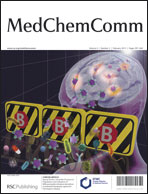A new route towards fimbrolide analogues: importance of the exomethylene motif in LuxR dependent quorum sensing inhibition†
Abstract
Sixteen analogues of fimbrolides (brominated 3-substituted-5-methylene-2(5H)-furanones), naturally occurring bacterial quorum sensing (QS)


 Please wait while we load your content...
Please wait while we load your content...